
PORTLAND & PORTLAND HARBOUR - FERRYBRIDGE - EAST FLETT AT TIDMOOR POINT - WEYMOUTH PORTLAND HARBOUR FROM SANDSFOOT CASTLE
WEATHER; mainly dry, overcast with some sunshine, rain later. Windy all day making it feel very cold. Temp 12C
We had many target species for today’s outing, some probable, some possible and others just a slight chance of seeing! It turned out that we had a lot of success with some disappointment, but all in all we had a great day out. Guy Campbell joined us for a second day and with Guy came the rain, but not until late afternoon.
The weather was kind to us for most of the day, it was overcast mostly and did start to rain around 2:30pm but the wind had dropped and it was dry mostly. Our birding began at Portland Bill around 8:45am, it was windy there and very chilly. We had noted several species along the way, including: Brent Geese, Oystercatchers (both trip ticks) and Common Kestrel.
Rock Pipits ran around the car park and the Lighthouse buildings and was a new species for the trip. This was quickly followed by Guillemot, Kittiwake, Gannet, Fulmar, Common Scoter, Cormorant, Shag and our most wanted species the Purple Sandpiper. We had some sunshine at this point and the light was excellent around the Bill area.
We walked along the rocky shore through the Bill Quarry to get a closer look at the Purple Sandpipers, they were roosting on the base of Pulpit Rock and were bathed in sunshine, posing nicely.
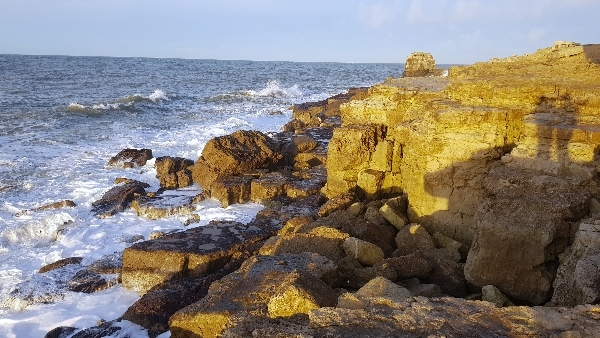
the rocks at the Bill were bathed in golden sunlight. Pulpit Rock in the distance was where the Purple Sandpipers were roosting, found by Graham
Looking east from the rocks we finally found a Razorbill on the water with some Guillemots and we saw a much closer Fulmar. Meadow Pipits and Goldfinches were seen as we walked back to the car. After a brief stop along the roadside and quick visit to the Obs Quarry we dipped on the resident Little Owl.
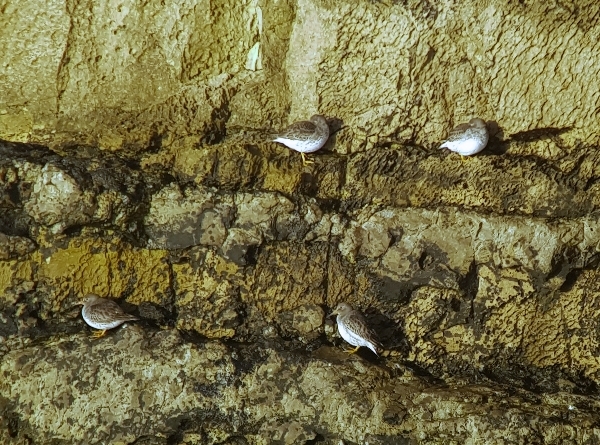
Purple Sandpipers at the base of Pulpit Rock
Our next target bird was the Cirl Bunting which has been frequenting a horse paddock in Reap Lane, Portland. After a short time searching we found it feeding below a metal gate very close to the horses, it seemed to be feeding well and looked exquisite in the morning sunlight. Other species seen there were Stonechat, Goldfinch, Meadow Pipit and a Sparrowhawk.
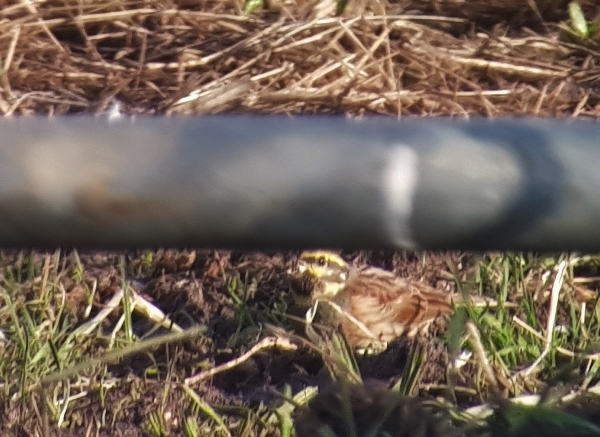
this elusive, colourful bunting was very hard to find let alone photograph - Cirl Bunting, male
Before driving off Portland we made a visit to the woodland which sits adjacent to Pennsylvania Castle and where a pathway leads you down to Church Ope Cove. The woodland was very active with many birds flitting about, mostly common garden birds such as Robin, Blackbird, Dunnock, Blue & Great Tit, Long-tailed Tit and Chaffinch. We also found a male Blackcap, a couple of Chiffchaff, several Goldcrests and our target bird the Firecrest. The latter was very flighty and didn’t stay around for long.
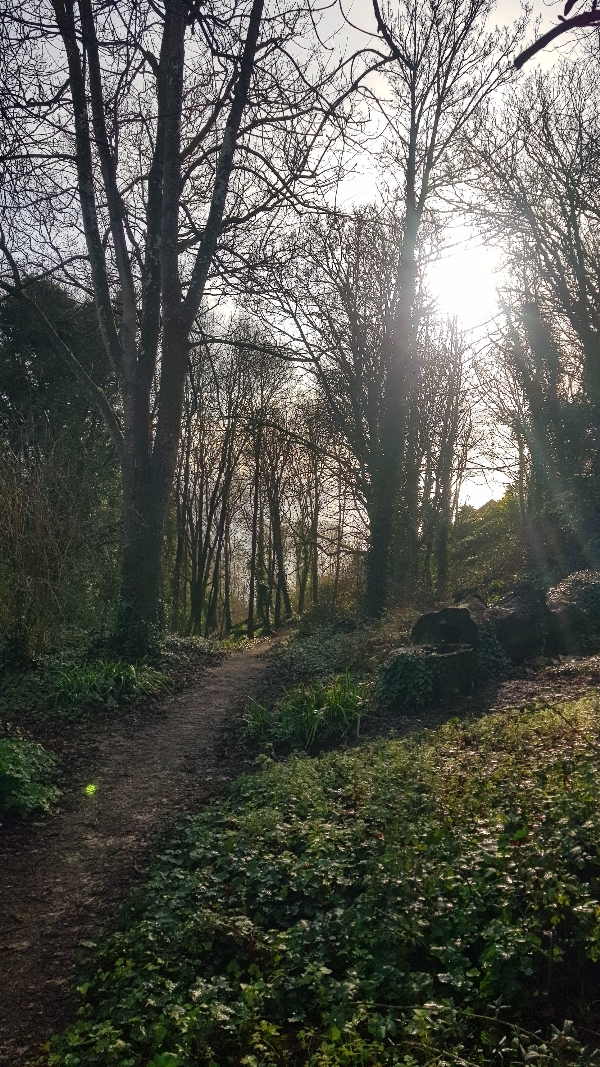
the woodland walk down to Church Ope Cove
We worked our way down to Church Ope Cove and searched for Black Redstarts, but none could be found, it was a long walk back to the woodland where we saw the Blackcap once again and the Firecrest reappeared, it was fairly high up but it showed for much longer this time.
At 11am we left the island and drove to Ferrybridge where I was forced to stop for coffee by my group. Scanning the mudflats afterwards produced sightings of Bar-tailed Godwits, Dunlin, Ringed Plover, Ruddy Turnstone, Curlew, Red-breasted Merganser, Brent Geese, Oystercatcher, Great Crested Grebe and well over a thousand Mediterranean Gulls.
A Peregrine Falcon flew over and put up the entire flock of gulls and waders, it was quite a spectacle, however, the Falcon was not interested in pursuing any bird for lunch and just flew off up the Fleet. At Ham Beach, Guy scanned the Harbour whilst the rest of us went in Lidl’s to buy lunch, which we ate at our next stop, Sandsfoot Castle.
Standing on the raised humps in the Castle Grounds we scanned the harbour searching for Grebes and Divers and in particular Red-necked Grebe, our most wanted species of the trip. We found four Eider Ducks, lots of Red-breasted Mergansers, a single Great Northern Diver and at least 3 Black-necked Grebes. Many Great Crested Grebes were also spotted but we could not turn any of them into a Red-necked Grebe.
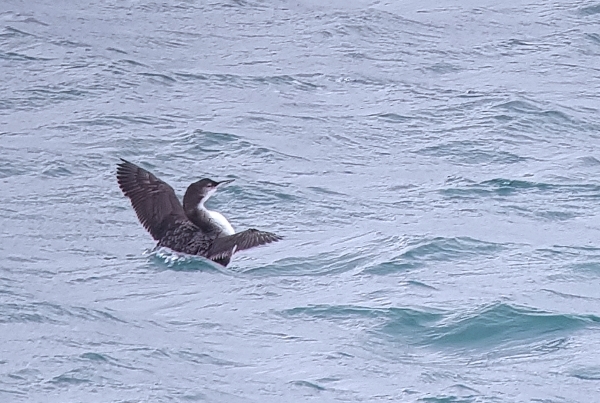
Great Northern Diver - I think he may have just sat on a Sea Urchin!
Another uncommon grebe, the Slavonian Grebe, has been seen several times along the east fleet and was favouring the water between Tidmoor Point and Chickerell Hive Point. My god was it muddy along the tracks and very slippery, our boots were caked in mud. The sky darkened and it started to drizzle with rain, I wasn’t hopeful of finding anything!
Lots of Brent Geese sat out on the water, along with Mute Swans and we found a couple of Curlews with three Redshanks. Scanning the ducks we discovered that all five ducks in the bay were in fact Greater Scaup, 4 female types and a juvenile male.
Walking round to Tidmoor point from the east we found the Slavonian Grebe, I think it was Mike Taylor who found it and ID’d it, well done Mike! It then started to rain, it drove us off, we had about a mile to walk back to the bus along some horrendously muddy tracks. We got soaked and muddy but hey, ho we got the bird, our fourth Grebe species of the trip.

two shots of the Slavonian Grebe - changing colour into summer plumage
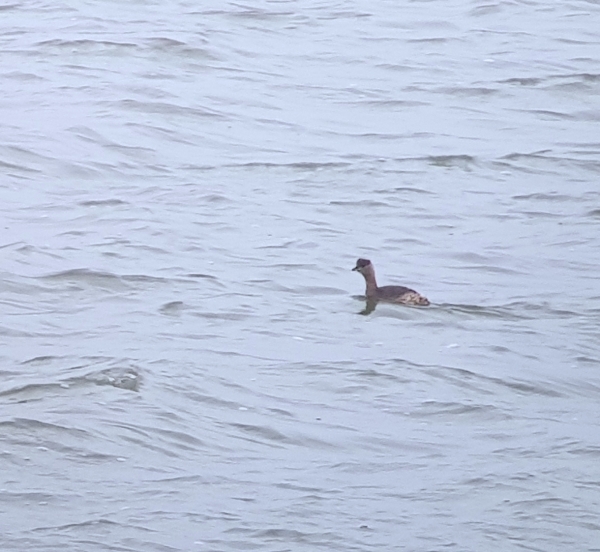
As we sat in the bus a message came through that the Red-necked Grebe had turned up again in Portland Harbour, observed from Sandsfoot Castle. So, off we went back to the castle, it was 3:30pm when we got there, the light and visibility was very poor and it was still raining. We search for about half-an-hour before calling it a day, the wind had picked up quite a lot too.
We dropped Guy back to his car and headed back to our guest house, desperately needing a hot drink which our host Sonia, provided for us.
